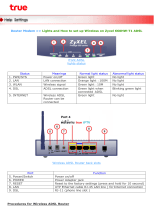
Table of Content
D-Link DVA-G3670B User Manual
2
Table of Contents
PRODUCT OVERVIEW..................................................................4
PACKAGE CONTENTS .....................................................................................................4
SYSTEM REQUIREMENTS................................................................................................4
INTRODUCTION ..............................................................................................................5
FEATURES ......................................................................................................................6
HARDWARE OVERVIEW .................................................................................................7
Connections ...........................................................................7
.................................................................................................7
LEDs........................................................................................8
INSTALLATION..............................................................................9
BEFORE YOU BEGIN .....................................................................................................9
INSTALLATION NOTES.................................................................................................10
INFORMATION YOU WILL NEED FROM YOUR ADSL SERVICE PROVIDER....................12
INFORMATION YOU WILL NEED ABOUT DVA-G3670B..............................................14
WIRELESS INSTALLATION CONSIDERATIONS.............................................................16
DEVICE INSTALLATION................................................................................................17
POWER ON ROUTER....................................................................................................17
NETWORK CONNECTIONS...........................................................................................18
CONFIGURATION........................................................................20
WEB-BASED CONFIGURATION UTILITY ......................................................................20
SETUP .......................................................................................................................21
WIZARD.................................................................................21
INTERNET SETUP ................................................................30
WIRELESS.............................................................................35
LOCAL NETWORK ...............................................................40
ADVANCED..............................................................................................................45
PORT FORWARDING............................................................49
PORT TRIGGERING..............................................................51
DMZ .......................................................................................53
PARENTAL CONTROL ..........................................................54
FILTERING OPTION..............................................................57
FIREWALL............................................................................. 61
DNS....................................................................................... 62
DDNS .................................................................................... 63
NETWORK TOOL ................................................................. 64
ROUTING.............................................................................. 68
SCHEDULES......................................................................... 70
TR-069 Client ........................................................................ 71
Print Server............................................................................ 72
VOIP ACCOUNT ................................................................... 74
PSTN CONNECTION............................................................ 75
LINE SETTINGS.................................................................... 76
PREFIX RULES..................................................................... 78
CALL REJECT SETTING ...................................................... 79
INCOMING CALL POLICY .................................................... 80
PEER TO PEER .................................................................... 81
TELEPHONY SETUP............................................................ 83
MAINTENANCE .................................................................... 85
SYSTEM................................................................................ 85
FIRMWARE UPDATE ............................................................ 87
ACCESS CONTROL ............................................................. 88
DIAGNOSTICS...................................................................... 91
SYSTEM LOG ....................................................................... 92
STATUS......................................................................................................................94
DEVICE STATUS................................................................... 94
WIRELESS CLIENTS............................................................ 96
DHCP CLIENTS .................................................................... 97
LOG....................................................................................... 98
STATISTICS .......................................................................... 99
ROUTE INFO ...................................................................... 101
TROUBLESHOOTING............................................................... 102
WIRELESS BASICS .................................................................. 104





















